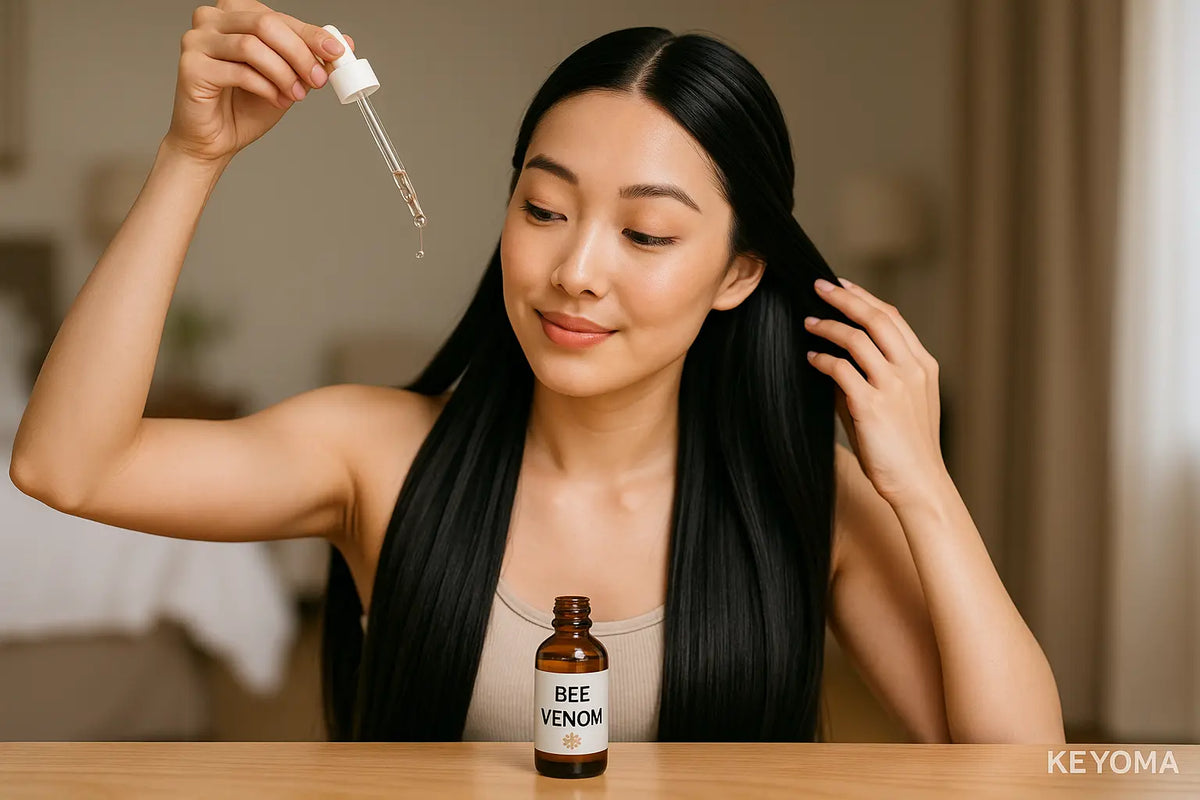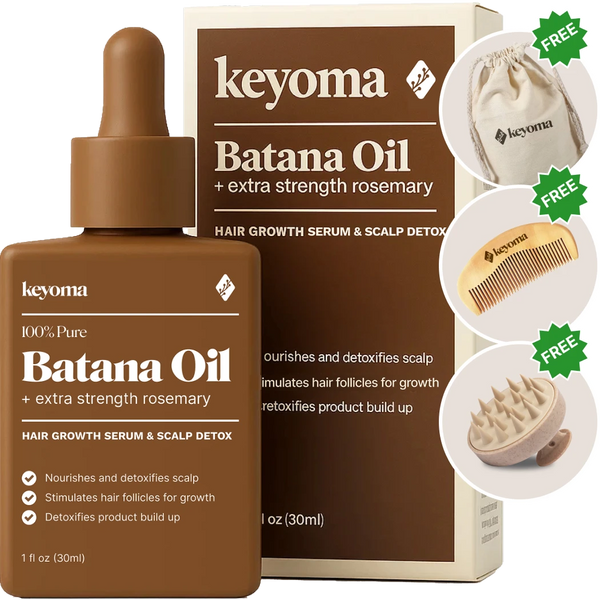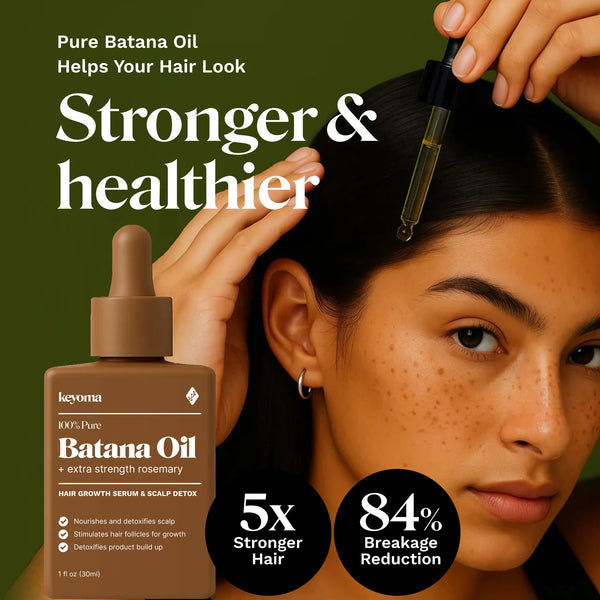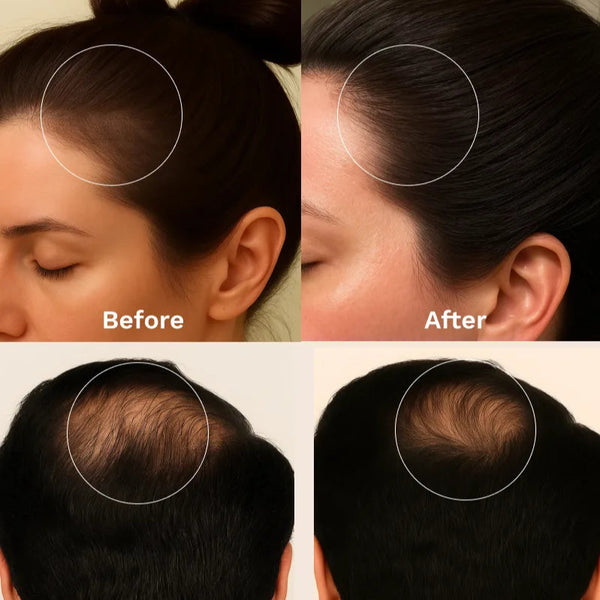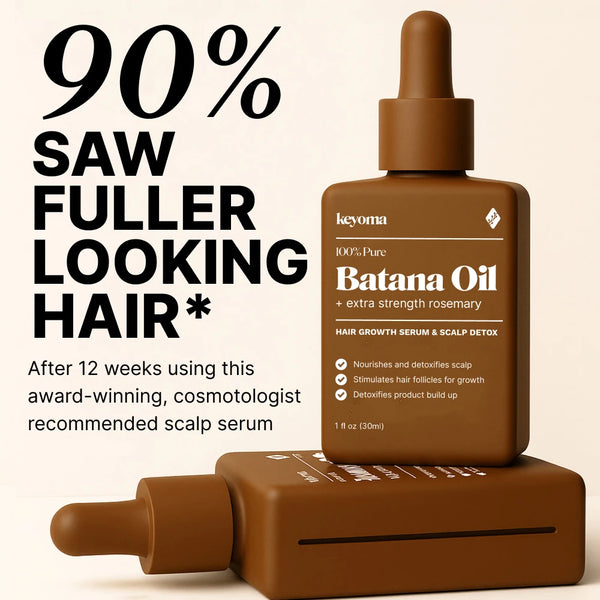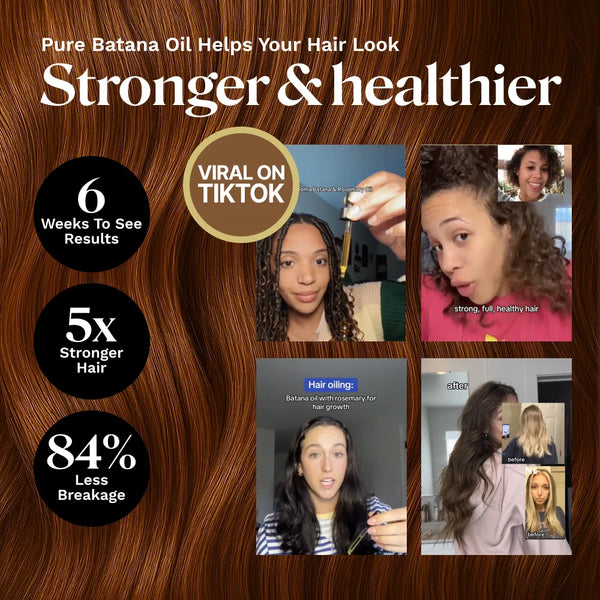In this article
If you've been following the Keyoma blog for a while, you already know how promising the science is around bee venom and its link to hair growth and thickness. (If not, definitely check that out. It's worth the read!).
And now that you've got the research side down, the next likely thing on your mind is how do I actually use bee venom products in my routine?
How do I apply them, how often, and in what order, so I’m not just using them randomly but actually making the most out of every drop?
That’s exactly what we'll talk about in this article. I'll walk you through how to build a practical weekly routine using different formats of bee venom, from shampoo and serums to sprays and powder blends. Let’s get into it!
Key Takeaways
-
Bee venom can be safely used daily across multiple formats, including serum, shampoo, spray, and powder blends.
-
Routine layering matters. Bee venom formats can be alternated throughout the week to target both the scalp and strands without overload.
-
Side effects are rare and usually mild, usually some temporary tingling or brief tightness that fades within hours of application.
Step-by-Step Bee Venom Hair Care Routine

Bee venom is usually marketed as serums, but you’ll also find it in shampoos, leave-in sprays, rinse-off conditioners, and even powders you can mix into nourishing oils or masks. Here’s how to work each version into your weekly routine.
Step 1: Patch Test and Screen for Allergy
Always patch test first, no matter which form you’re using—even if you’ve tried them before. Better safe than sorry to rule out any reaction.
Apply a pea-sized amount behind the ear or on the inner forearm and leave it for 24 hours.
Mild tingling is fine. But if you notice redness, hives, or more serious symptoms like breathing troubles, that’s your sign to stop.
If you’re pregnant or breastfeeding, I recommend getting clearance from your doctor first. And definitely avoid applying it to broken or inflamed scalp.
Step 2: Cleanse With a Bee Venom Shampoo
Wet your hair thoroughly with lukewarm water, then squeeze a small amount of bee venom shampoo into your palm. Massage it directly into your scalp using your fingertips (not your nails), section by section.
Take your time here. Two to three minutes of massaging is the sweet spot to help stimulate blood flow in your scalp while giving bee venom enough contact time. Rinse thoroughly afterwards.
You only need to use bee venom shampoo two to three times a week. On in-between days, you can either co-wash (if your hair type allows) or simply rinse with water, especially if you're not dealing with sweat or buildup.
You might need to rotate shampoos if you're also targeting dandruff or oil control.
Step 3: Layer in a Bee Venom Conditioner or Spray
Right after shampooing, gently towel-dry your hair until it's damp—not dripping. This makes sure your next product actually sticks and absorbs instead of sliding right off.
Then do one of the following depending on your hair type and what your scalp needs that day:
-
Use a bee venom conditioner if your strands feel dry, brittle, or frizzy. Apply it to damp hair, mid-length to ends—never the roots. Let it sit for 1–2 minutes, then rinse with cool water.
-
Use a leave-in bee venom spray if your scalp needs lightweight hydration or if you're skipping wash day. Mist it directly near the roots and scalp, then gently comb through.
This step matters because your hair shaft is more porous after shampooing. That means it's the perfect window to lock in moisture, smooth the cuticle, and help prevent further breakage.
Step 4: Apply Bee Venom Serum (Night Routine)
Bee venom serums are perfect for deep overnight conditioning—especially if you need scalp repair, like when you’re dealing with thinning spots, irritation, or breakage.
Part your hair into sections using your fingers or the tip of an applicator bottle. Apply 1–2 drops of serum per section directly onto the scalp. Massage each area gently with your fingertips for about a minute to help the product absorb and improve circulation, then leave it overnight.
If you have an oily scalp, overnight application might feel too heavy or cause buildup over time. In that case, apply the serum, leave it on for a few hours, and rinse before bed.
Start with 3 nights per week and build up slowly based on how your scalp reacts.
Alternative
If you prefer something more customizable, bee venom powders are a great option. You can mix a pinch of powder into:
-
lightweight carrier oils (like batana, jojoba, or grapeseed)
-
plain aloe gel
-
a nourishing hair mask or cream
If it’s an oil- or gel-based mix, apply the blend to parted sections of your scalp, massage gently, and leave it on overnight (just like the serum). If you’re using a mask or cream meant to be rinsed out, leave it for at least 30 minutes, then wash it off.
Step 5: Support the Scalp Barrier
This step is about what to do on the nights you’re not using bee venom products. You’ll want to focus on keeping your scalp calm, hydrated, and irritation-free so it can better handle active ingredients the next time you apply them.
Here’s what to do:
-
Spray a fragrance-free aloe mist or pat on a lightweight, scalp-safe hydrator. These help cool and rehydrate the scalp without clogging follicles.
-
Use a few drops of a gentle carrier oil like jojoba, almond, or batana oil if your skin feels dry or tight. Massage lightly.
-
Don’t apply acids, scalp scrubs, retinoids, or essential oils on the same night. They can trigger irritation, especially when used too close to bee venom.
-
Avoid tight ponytails, braids, or heat tools that put extra stress on your roots.
If irritation builds or your scalp starts flaking, take a break. Simplify your routine for a few days and reintroduce products one at a time.
Bee Venom Hair Serum Application Tips
We've already touched on bee venom serums earlier but I think they deserve their own section considering they’re typically the first format people try—and the one they stick with most consistently.
They’re quick, potent, and don’t require much rinsing, making them perfect for busy routines or targeted treatment. Here are some practical tips to help you apply bee venom serums more effectively.
-
Start with clean, damp or dry scalp. Serums work best when applied to a freshly washed or dry scalp, free from buildup or styling residue. You want the product to reach the skin, not just sit on oily hair.
-
Use an applicator for even distribution. Whether it’s a dropper or nozzle, part your hair into 4–6 sections and apply 1–2 drops per line. Focus on areas where thinning or irritation is happening.
-
Massage, don’t rub. Use your fingertips to gently press and massage the serum in. This improves absorption and also boosts blood flow, which may help support growth signals.
-
Don’t wash too soon. Bee venom serums are leave-in for a reason, and washing your scalp right after applying cuts short the window where the venom is actively working. If you really need to rinse, give it at least a few hours.
-
Apply at night for deeper contact. The longer it sits, the more time it has to work. Overnight is best, especially if you’re trying to repair scalp damage or support regrowth in sparse areas.
-
Adjust based on how your scalp feels. Daily use is generally safe, but if you notice redness, dryness, or itching, scale back to every other night until your scalp adjusts.
-
Pair with a soothing off-day routine. Use aloe mists, light oils, or scalp hydrators on off-nights to help your skin reset and stay balanced in between active treatments.
Can I Combine Bee Venom With Natural Oils?
Yes, it's possible to combine bee venom with natural oils—and in many cases, you should. The most common purpose is a deep scalp treatment oil.
Mix a pinch of bee venom powder with lightweight carrier oils like jojoba, batana, or grapeseed. These oils are non-comedogenic and safe for most scalp types. Apply a few drops to parted sections of the scalp, massage gently, and leave overnight.
Bee venom pairs really well with natural oils and can even be more effective when used this way, especially if you're dealing with dryness, flaking, or want to build your own overnight treatment.
Does Bee Venom Really Help With Hair Growth?
Studies have shown that bee venom can indeed support hair growth. I’ve previously gone in-depth on what the science reveals about it, and one research found that bee venom outperformed minoxidil in terms of regrowth results—and that says a lot, considering minoxidil is the standard treatment most doctors prescribe.
That helps explain why so many are turning to bee venom serums, especially if their instinct is to reach for something natural rather than rely too heavily on synthetic drugs.
Bee venom works by stimulating hair follicles through multiple pathways. It triggers the release of growth signals like FGF, VEGF, and IGF, while also helping stem cells move through the hair cycle faster. In simple terms, it tells dormant follicles to re-enter the growth (anagen) phase.
There’s also data specific to androgenetic alopecia. Studies suggest bee venom can inhibit 5-alpha-reductase type II—the same enzyme that converts testosterone into DHT, the hormone responsible for shrinking follicles over time.
And by lowering DHT activity, bee venom may help slow or even reverse the miniaturization process seen in pattern hair loss.
Is Daily Use of Bee Venom Products Safe?
Daily use of bee venom products is generally safe for both your hair and scalp—when used as directed. Most formulas, especially serums, are designed to be gentle enough for everyday use without disrupting the skin barrier or causing buildup on the hair shaft.
That said, how your scalp responds still matters. Some people start with three nights a week and gradually work their way up to daily use. If you notice signs of irritation like itching, dryness, or redness, it’s best to scale back to every other day or take a short break.
As long as you’re patch testing first, using a clean applicator, and keeping the rest of your routine balanced (hydrating on off-nights, avoiding strong actives or scrubs), bee venom can absolutely be part of a consistent, daily care routine.
Are There Any Side Effects of Using Bee Venom for Hair?
Yes, although most side effects are mild and temporary. Bee venom is an active ingredient, so it’s normal to feel a slight tingling sensation when you apply it. That usually fades within minutes. For most people, that’s the extent of it.
But if you have sensitive skin or a history of bee allergies, you’ll want to be extra cautious. Reactions can include:
-
redness or irritation at the application site
-
dry or tight scalp feeling after repeated use
-
small bumps or flaking if applied too frequently without enough hydration support
Serious reactions like swelling or difficulty breathing are extremely rare, but not impossible, especially in those with undiagnosed bee sting allergies.
How Long Does It Take For a Bee Venom Hair Routine to Show Results?
By the 6- to 8-week mark, you’ll usually notice subtle changes like reduced scalp tightness and less shedding. But when it comes to visible, photo-worthy growth, that often takes 16 weeks or more.
If that feels a little slow, that’s just how hair works. Follicles move in cycles, and it takes time for them to re-enter and stay in the growth (anagen) phase long enough to show real surface changes.
Consistency is key. Whether you’re using a bee venom serum, shampoo, or powder blend, the most important thing is to stick with your routine. Even better, take progress photos every month in the same lighting and from the same angles so you can actually track the difference.
Build a Bee Venom Hair Care Routine With Intention
By now, you’ve seen that bee venom isn’t just a one-and-done product. It comes in multiple forms—shampoo, conditioner, spray, serum, and powder. What's more, You can even pair it with nourishing oils, gels, and masks for extra scalp support, giving you the flexibility to layer them throughout your week depending on your needs.
But at the end of the day, what matters most is that you’re holding a bee venom product backed by real data. One that’s shown promise not just in reducing shedding but also in supporting real regrowth.
So keep going. Track your progress. Adjust when needed. And trust that you’re giving your hair and scalp something that’s both natural and proven to work.
Featured Product
100% Pure Batana Oil + Rosemary
↓Best Batana Oil to Buy↓
1 Month
Subscribe & Save
- 30-day supply delivered monthly $35
- 30% off for life $6
- Free haircare essentials kit $33
- Free custom wooden comb $10
- Free scalp massager $15
- Free eco-friendly travel bag $8
- 30-Day Money Back Guarantee
- Free Shipping
- Online portal for easy cancel, skip, or pause.
1 Month One Time Purchase
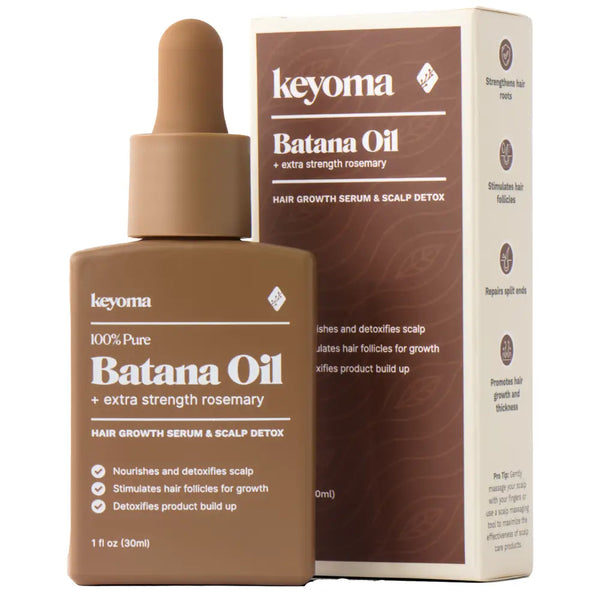
- 30-day supply $50
- 30% off for life $6
- Free haircare essentials kit $33
- Free custom wooden comb $10
- Free scalp massager $15
- Free eco-friendly travel bag $8

